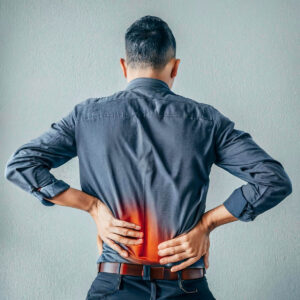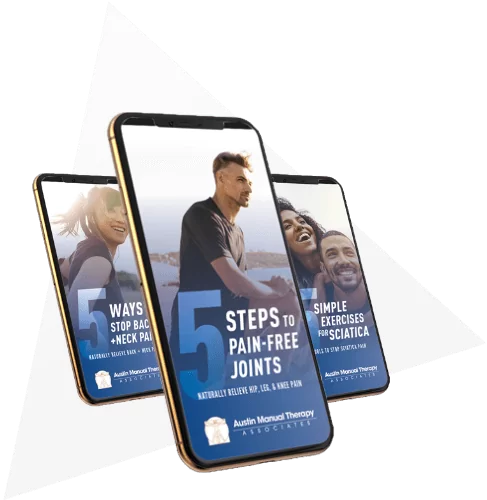Most people will experience back pain at some point in their lives. However, this doesn’t mean that you should view your pain as a normal, inescapable aspect of life.
Back pain itself can hinder your ability to reach, lean, kneel, lift or bend. It can also hinder your time spent with friends and family. For some people, when left untreated, lower back pain can even lead to long-term pain, dysfunction and even nerve damage.
This is why it is so important to be proactive when it comes to treating back pain. With guidance from your physical therapist, you can find solutions to your pain and learn how to manage it, so you can prevent any long-term damage.
What causes back pain?
Mechanical low back pain originates in and around the spine. The injury or irritation of the muscles, joints (including the intervertebral discs and facet joints), nerves or surrounding ligaments, and other soft tissue causes the pain you experience.
Back pain is frequently associated with the following factors:
- Improper posture or prolonged positions (i.e. prolonged sitting)
- Spinal muscle and tissue damage (i.e. lifting strains or trauma from accidents)
- Limited hip, spine and pelvis mobility
- Limited muscle flexibility
- Spinal/pelvic muscle weaknesses (aka “core” weakness)
- Poor abdominal, pelvic and back muscle coordination (i.e. compensations due to injury)
Unfortunately, many people do not seek treatment when they experience back pain. They may believe that nothing, except medication and rest, can alleviate their back pain. However, there is little to no evidence that acetaminophen, skeletal muscle relaxants, or lidocaine patches are effective in the treatment of chronic low back pain.
Physical therapy, on the other hand, has been proven time and time again to help relieve back pain and restore function.
Physical therapy: a safe, natural, and effective solution
According to research on back pain, physical therapy treatments are effective for acute and chronic conditions. Manual therapy, joint mobilization manipulation, exercise instruction, education, and techniques such as the McKenzie Method and therapeutic yoga are examples of physical therapy treatments for back pain. All of these have been shown to help relieve pain and restore function.
Physical therapists evaluate your specific condition to identify and address all contributing factors of your back pain. Rather than focusing on a single source of pain, your physical therapist will address all of them.
At Austin Manual Therapy, our physical therapists are experienced in hands-on intervention and exercise selection. So you can be sure you’ll receive the most comprehensive and appropriate treatment plan to help you resolve your pain and/or restore your function.
How to prevent back pain
Not only can your physical therapist relieve your back pain, they can ensure that it returns less frequently or not at all. Your physical therapist may recommend the following practices to prevent back pain.
1. Limit Sitting For Too Long
Prolonged sitting is not good for your back, or your overall health. Although adjusting your posture while sitting can be beneficial, standing up at regular intervals throughout the day is a more effective option.
Try to sit for no more than 30-45 minutes at a time. You’ll be surprised by the results!
2. Use Good Posture
Because our spine is designed to move, so should our posture. The spine does not like to stay in one position for long periods of time. Most people slouch and then remain in that position for long periods of time. You can counteract the slouch by finding a “good” posture.
Imagine your breast bone is lifted towards the sky as you stand. This will naturally straighten your spine, lifting you up and keeping your hips, spine, shoulders, and neck aligned.
3. Use Strength Training
There are hundreds of muscles in your body. Your spine is protected and controlled by these muscles. You can keep them strong by lifting weights, running, and swimming. Train the muscles in your hips, pelvis, and spine, also known as your core muscles.
Request an appointment with Austin Manual Therapy today!
Though back pain can sometimes go away on its own, it’s never a good idea to ignore pain warning signs in your body. Be proactive with your treatment and visit an Austin, TX physical therapist for a comprehensive assessment.
Here you’ll learn what steps you can take to alleviate your pain and prevent further episodes. If you have a history of back injuries, pain or minor aches, don’t hesitate to talk to a physical therapist. We are looking forward to treating you!
Sources
https://pubmed.ncbi.nlm.nih.gov/30252425/
https://pubmed.ncbi.nlm.nih.gov/32669487/
https://pubmed.ncbi.nlm.nih.gov/29602304/
https://pubmed.ncbi.nlm.nih.gov/27285608/
https://www.ncbi.nlm.nih.gov/pmc/articles/PMC2200681/
https://www.health.harvard.edu/pain/dont-take-back-pain-sitting-down






